Stack operations - Study guides, Class notes & Summaries
Looking for the best study guides, study notes and summaries about Stack operations? On this page you'll find 613 study documents about Stack operations.
Page 4 out of 613 results
Sort by

-
WGU C949 STUDY GUIDE QUESTIONS AND ANSWERS
- Exam (elaborations) • 18 pages • 2023
-
Available in package deal
-
- $14.49
- + learn more
Array A data structure that stores an ordered list of items, with each item is directly accessible by a positional index. Linked List A data structure that stores ordered list of items in nodes, where each node stores data and has a pointer to the next node. Bianary Search Tree A data structure in which each node stores data and has up to two children, known as a left child and a right child. Hash Table A data structure that stores unordered items by mapping (or hashing)...
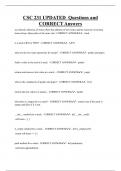
-
CSC 231 UPDATED Questions and CORRECT Answers
- Exam (elaborations) • 5 pages • 2024
-
- $9.99
- + learn more
CSC 231 UPDATED Questions and CORRECT Answers an ordered collection of items where the addition of new items and the removal of existing items always takes place at the same end - CORRECT ANSWER- stack is a stack LIFO or FIFO? - CORRECT ANSWER- LIFO what are the two main operations for stacks? - CORRECT ANSWER- push() and pop() Adds a value to the end of a stack. - CORRECT ANSWER- push()
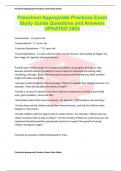
-
Preschool Appropriate Practices Exam Study Guide Questions and Answers UPDATED 2024
- Exam (elaborations) • 14 pages • 2024
-
Available in package deal
-
- $12.99
- + learn more
Sensorimotor - 0-2 years old Preoperational - 2-7 years old Concrete-Operational - 7-11 years old Formal Operations - 11 years old and older -Correct Answer According to Piaget, the four stages of cognitive development are: Provide open-ended, hands-on activities so children can progress through as they develop transformation (the ability to use an object to represent something real), classifying, and logic. (One child may squish and pound modeling clay, while another might roll snakes ...
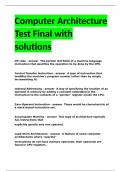
-
Computer Architecture Test Final with solutions
- Exam (elaborations) • 33 pages • 2024
-
- $13.99
- + learn more
OP code The portion (bit field) of a machine language instruction that specifies the operation to be done by the CPU. Control Transfer Instruction A type of instruction that modifies the machine's program counter (other than by simply incrementing it). Indexed Addressing A way of specifying the location of an operand in memory by adding a constant embedded in the instruction to the contents of a "pointer" register inside the CPU. Zero-Operand Instruction These would b...
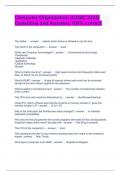
-
Computer Organization (COSC 2325) Questions and Answers 100% correct
- Exam (elaborations) • 13 pages • 2023
-
Available in package deal
-
- $18.99
- + learn more
Computer Organization (COSC 2325) Questions and Answers 100% correct The arbiter... selects which device is allowed to use the bus The Clock is the computer's... heart Which are Computer Technologies? -Semiconductor technology -Peripherals -Magnetic materials -Application -Optical technology -Busses What is Cache memory? high speed memory that frequently holds used data, so that it can be accessed quickly What is RAM? A type of memory where each word can b...
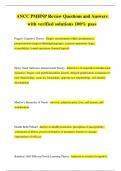
-
ANCC PMHNP Review Questions and Answers with verified solutions 100% pass
- Exam (elaborations) • 21 pages • 2023
- Available in package deal
-
- $14.49
- + learn more
Piaget's Cognitive Theory –Stages: sensorimotor (object permanence), preoperational (magical thinking/language), concrete operations (logic, reversibility), formal operations (formal,logical) Henry Stack Sullivan's Interpersonal Theory –behavior is in respond to interpersonal dynamics. Stages: oral gratification/first anxiety, delayed gratification, formation of peer relationships, same sex friendships, opposite sex relationships, self-identity development
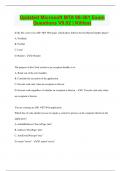
-
Updated Microsoft MTA 98-361 Exam Questions V9.02 | Killtest
- Exam (elaborations) • 7 pages • 2024
-
- $9.99
- + learn more
Updated Microsoft MTA 98-361 Exam Questions V9.02 | Killtest In the life cycle of an ASP. NET Web page, which phase follows the SaveStateComplete phase? A. PostBack B. Postlnit C. Load D. Render - D. Render The purpose of the Catch section in an exception handler is to: A. Break out of the error handler. B. Conclude the execution of the application. C. Execute code only when an exception is thrown. D. Execute code regardless of whether an exception is thrown. - C. Execute code o...

-
WGU C949 Data Types STUDY GUIDE with correct answers.
- Exam (elaborations) • 10 pages • 2023
-
- $13.99
- + learn more
Array A data structure that stores an ordered list of items, with each item is directly accessible by a positional index. Linked List A data structure that stores ordered list of items in nodes, where each node stores data and has a pointer to the next node. Bianary Search Tree A data structure in which each node stores data and has up to two children, known as a left child and a right child. Hash Table A data structure that stores unordered items by mapping (or hashing)...

-
CSE 240 Final | 178 questions| with complete solutions
- Exam (elaborations) • 30 pages • 2023
-
Available in package deal
-
- $12.99
- + learn more
If a function calls another function, the local variables in these two functions use the memory from correct answer: different stack frames. Which C/C++ operations will acquire memory from heap? Select all that apply. correct answer: - new - malloc You do not need to garbage-collect the memory, if it comes from (Select all that apply) correct answer: - global memory - stack memory - static memory What is the key difference between a static variable and a global variable? correct a...
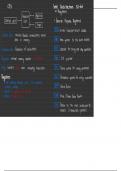
-
CS2130 - Exam 2 Study Notes
- Summary • 9 pages • 2024
-
- $9.39
- 1x sold
- + learn more
Prepare effectively for your CS2130 Exam 2 with these comprehensive study notes. This document covers all the essential topics you need to master, including: x86 Assembly Language: Gain a solid understanding of the x86 assembly, its syntax, and structure. Registers: Learn about the different types of registers in the CPU, their functions, and how they are used in assembly programming. CPU and Stack: Understand the relationship between the CPU and the stack, including stack operations and ma...

$6.50 for your textbook summary multiplied by 100 fellow students... Do the math: that's a lot of money! Don't be a thief of your own wallet and start uploading yours now. Discover all about earning on Stuvia


